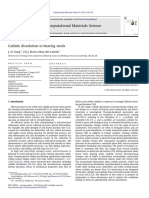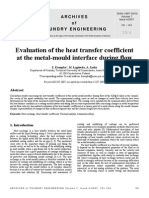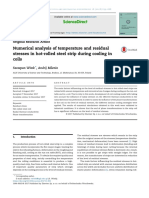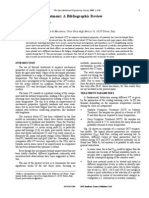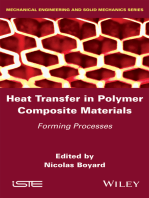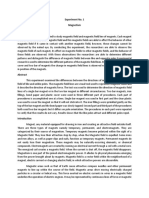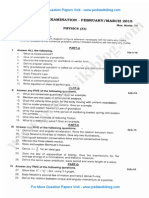Modeling Solidification Microstructures of Steel Round Billets Obtained by Continuous Casting
Modeling Solidification Microstructures of Steel Round Billets Obtained by Continuous Casting
Uploaded by
mbgepCopyright:
Available Formats
Modeling Solidification Microstructures of Steel Round Billets Obtained by Continuous Casting
Modeling Solidification Microstructures of Steel Round Billets Obtained by Continuous Casting
Uploaded by
mbgepOriginal Title
Copyright
Available Formats
Share this document
Did you find this document useful?
Is this content inappropriate?
Copyright:
Available Formats
Modeling Solidification Microstructures of Steel Round Billets Obtained by Continuous Casting
Modeling Solidification Microstructures of Steel Round Billets Obtained by Continuous Casting
Uploaded by
mbgepCopyright:
Available Formats
ISIJ International, Vol. 51 (2011), No. 9, pp.
14481453
Modeling Solidification Microstructures of Steel Round Billets
Obtained by Continuous Casting
Giovanni STRAFFELINI,1) Luca LUTTEROTTI,1) Matteo TONOLLI1) and Massimo LESTANI2)
1) Department of Materials Engineering and Industrial Technology, University of Trento, via Mesiano 77, Trento, 38050 Italy.
2) STG Group S.p.A., Gessate, Milano, Italy.
(Received on March 4, 2011; accepted on May 16, 2011)
The knowledge of the position of the columnar to equaxial transition (CET) is of paramount importance
to evaluate the internal quality of continuous casting (CC) products. One way to control the operational CC
conditions with the objective of assuring a given quality level is to develop a numerical program able to
calculate the local solidification rate (R), the local thermal gradient (G) and the local time of solidification
(tf) and to relate these parameters to the CET by means of a predictive model. In the present investigation,
the dendritic morphology and the CET transition of three round billets made of a low carbon steel
(0.14%C) and produced by CC are characterized, and a computer model is developed to evaluate the R,
G and tf-parameters. Referencing the well-known CET transition model developed by Hunt, a simple prediction equation is thus obtained for the steel under study and it is used to propose guidelines for the
optimization of the CC operational parameters.
KEY WORDS: continuous casting; columnar to equiaxial ratio; solidification; prediction model; steel round
billet.
zone ratio is increased by optimizing the casting parameters
such as the casting speed, the superheating of liquid steel in
the tundish, and the cooling conditions, or by adopting specific electromagnetic stirrers that break the dendrite tips and
thus increase the local density of equiaxed grains.
In steels solidified by CC, solidification occurs with a
dendritic morphology in both the columnar and the equiaxed
regions. Two parameters are commonly used to characterize
such a morphology, i.e., the primary (1) and secondary (2)
arm spacing. These parameters can be evaluated by the
following relations based on theoretical solidification
models:6,7)
1. Introduction
The solidification of steel products by continuous casting
(CC) is continuously increasing. A fundamental task of the
CC method is the optimization of the processing parameters
to minimize the formation of defects in the products.1)
The grain structure of CC products is typically characterized by the presence of small grains in the outer chill zone,
elongated grains in the intermediate columnar zone and
randomly oriented grains in the central equiaxed zone. The
transition from the columnar growth to equiaxed growth
(usually called CET) occurs when the columnar front is
blocked by the growing equiaxed grains nucleated in the
liquid ahead of the solidifying front.2) The occurrence of
such a transition can be predicted by Hunts model:3)
1 =
2 = M t 1f /3 ................................ (3)
T 3
G < 0.6 N 01/3 Tc 1 n3 .................. (1)
Tc
where R is the growth velocity of the columnar solidifying
front, tf is the solidification time, and N and M are materials
constants.7) The secondary arm spacing (2) is an important
microstructural parameter with regard to internal defects.5)
To optimize the CC parameters with the aim of reducing
the internal defects, it is therefore of paramount importance
to develop of a heat transfer model able to predict the
parameters G, R and tf on the product cross section, i.e., at
the solidifying front for the whole metallurgical length. In
this way it is possible to predict the role of the operating
parameters including the tundish superheating, the cooling
conditions, and the billet or slab size.
This work investigated the solidification (without stir-
where G is the thermal gradient at the solidifying front, N0
is the number density of nuclei of critical size, and Tn and
Tc are the nucleation and constitutional undercooling,
respectively, in the liquid in which the grains grow.
The position of the CET is an important parameter since
it plays a role in the formation of the internal defects. In
particular, a large columnar region favors the formation of
centerline segregation, cracks and porosity. Several experimental investigations show a clear decrease in the centerline
segregation as the equiaxed zone ratio (given by the ratio of
the length of the equiaxed to the columnar regions, measured
on a product section) increases.1,4,5) In practice, the equiaxed
2011 ISIJ
N
............................. (2)
R1/ 4 G1/ 2
1448
ISIJ International, Vol. 51 (2011), No. 9
Table 1.
Casting parameters.
Cast speed,
m/min
Water flow rate in
mould, m3/h
Mould thickness,
mm
Temperature increase
of cooling water
in mould, C
Cooling water in
the secondary region,
l/kg-steel
210 mm round billet
1.1
110
18
5.4
0.75
250 mm round billet
115
20
5.7
0.55
280 mm round billet
0.8
120
22
5.4
0.45
410 mm round billet
0.5
147
24
5.3
0.3
ring) of CC round billets with different diameters. A computer program was developed to simulate the casting
process, and in particular to evaluate the parameters G, R
and tf as a function of the distance from the product surface.
A simplified approach is then proposed to estimate the position of the CET and thus to obtain guidelines for the optimization of the CC process.
(a)
2. Materials and Experimental Method
Four steel round billets with diameters of 210, 250, 280
and 410 mm were produced by CC. Their nominal chemical
composition was: 0.14%C, 1%Mn, 0.3%Si, 0.02%P,
0.015%S, 0.1%Cr, and 0.25%Cu. Table 1 summarizes the
CC operating conditions. The pouring temperature was
1 556C for each billet, corresponding to a superheat in the
tundish of 40C.
The round billets with a diameters of 210, 250 and 280
mm were submitted to a metallographic investigation. Two
sections for each product were investigated with the aim of
revealing their dendritic microstructures. For this, the samples were etched with the following solution:8) 4 g FeCl3,
0.3 g CuCl2, 0.4 ml HCl, 50 ml H2O. The etching duration
was in the range of 30 to 60 s. Figure 1 shows an example
of the dendritic morphology in the case of the round with a
diameter of 280 mm.
The dendrite arm spacings 1 and 2 were measured using
an image analyzer interfaced with the optical microscope.
At the surface of each sample, a magnification of 12.5 was
used. At the center, a magnification of 10 was used. The
variation of 1 and 2 as a function of the distance from the
surface was then obtained. For each section, the measurements were taken in two positions, i.e., from the surface to
the center in two random directions forming an angle of
180. The reported profiles are therefore the mean values of
four measurements.
The microstructural observations also yielded the position
of the CET. Four measurements were also taken for this
parameter, and the average values are reported.
(b)
Fig. 1.
Example of the dendritic morphology observed close to the
surface (a) and at center (b) of the round billet with a diameter of 280 mm.
T
k
r r
* T
= C p t ..................... (4)
where T is the temperature, t is time, k is the thermal conductivity of the steel and Cp*, is its effective specific heat.
For solid steel, k depends on temperature, and the relationship reported in Ref. 9 is used. For liquid steel, an effective
value was selected to account for the effects of bulk convection. k was set to 100 W/mK, in agreement with data
reported in Refs 10 and 11. In the mushy zone, k was calculated using the rule of mixtures. The fraction of solid in
the mushy zone, fs, depends on temperature and on the liquidus and solidus temperatures that were calculated using
the relations reported in Ref. 12. The effective specific heat,
Cp*, is defined as:
3. Heat Transfer Model
In CC products solidification starts in the mould where
flowing water removes heat through the mould wall. Solidification then continues in the secondary zone, where water
sprays remove heat from the solidifying surface. The
advancement of the solidifying front up to complete solidification was studied using the Fourier equation for heat conduction under non-steady conditions, with the assumption
that heat is extracted in the transverse section along the
radial r coordinate (r=0 at the center of the round billet):1,9)
C *p = C p L
dfs ............................ (5)
dT
where Cp is the specific heat capacity of steel (for liquid
steel Cp=825 J/kg K, for solid steel Cp depends on temper1449
2011 ISIJ
ISIJ International, Vol. 51 (2011), No. 9
ature,9) and in the mush zone Cp was evaluated by means of
the rule of mixtures), and L is the latent heat of steel (L=272
kJ/kg).
In the mold, the boundary condition was set by considering the following relation for the local heat flux density:13)
conducted for the other round billets, but we did measure the
surface temperatures at the exit of the mold and after the
first secondary cooling zone with satisfactory results. For
example, the measured temperatures for the 210 mm round
billet were 1 180C and 1 090C, whereas the predicted
values are 1 170C and 1 085C. The model is furthr validated indirectly in the next section, where the model predictions are used to estimate the dendrite arm spacings.
q( z ) = qa e z .............................. (6)
where z is the coordinate along the round axis (z=0 at the
meniscus), is a constant (it was set to 1),14) and qa is the
local apparent heat flux density at the meniscus. It can be
determined that:15)
qa =
4. Results and Discussion
Figures 3(a) and 3(b) presents the results of the metallographic evaluations of 1 and 2. As expected, and in
agreement with the literature data, both 1 and 2 increase
by moving toward the interior of the section, and 2 is
around one half of 1.7) Further, both 1 and 2 reach plateaus at the center of the samples, almost at the same distance from the surface. Within the plateau, the scatter of the
experimental measurements is higher than in the columnar
region (the scatter bars are not reported to avoid undue confusion in the graphs), because 1 and 2 are more difficult
to define there.8) As already observed,7,8) this behaviour can
be attributed to the transition from columnar to equiaxed
growth (CET). This result is in agreement with the experimental measurements of the position of the CET listed in
Table 2 (Fig. 4 shows a region with the transition from
columnar zone to the equiaxed zone). This table also
includes the ratios between the CET and the radius of each
round billet.
The results shown in Fig. 3(b) further show that the
TwT W CW Q
1
............. (7)
Pm
1 e H m
where w and Cw are the density and the specific heat of
water at the average temperature in the mold, TTw is the
total increase in the cooling water temperature, Pm and Hm
are the perimeter and length of the mold, respectively, and
Q is the volume flow rate of cooling water.
In the secondary cooling region, the boundary conditions
are given by the heat exchange due to convection and radiation. The coefficient of convection, hc, was thus calculated
using the following relation:13)
hc = 392.5 Ww0.55 (1 0.0075 Tw ) .............. (8)
where Ww is the volumetric water flow rate of secondary
cooling and Tw is the temperature of the cooling-water
spray. The coefficient of radiation was calculated using the
usual Stefan-Boltzmann equation. The cooling effect exerted
by the rollers played a minor role and was neglected here.
Equation (4) was then solved by the finite-difference
method using a program made using Java code. The input
parameters of the programme are: steel composition, casting
temperature and speed, round billet size, volume flow rate
of cooling water in the mold, and the cooling conditions of
the different zones in the secondary region.
The program was first validated using the analytical
model developed by Alizadeh et al.15) and the shell thickness profile reported in Ming et al.12) In addition, the model
was validated by measuring the surface temperatures in different locations on the 410 mm diamater round billet using
a pyrometer. Figure 2 compares the predicted temperature
profile with the measured data points, demonstrating that the
agreement between the predicted values and the pyrometer
measurements is quite good. This procedure could not be
(a)
(b)
Fig. 2.
Comparison between the predicted temperature profile and
the measured data points for the 410 mm diamater round
billet.
2011 ISIJ
Fig. 3.
1450
Average values of primary (a) and secondary (b) arm spacings for the billets under study.
ISIJ International, Vol. 51 (2011), No. 9
Table 2.
Experimental data for the onset of the plateau of 2 and for the CET.
Distance from the surface of the
onset of the plateaux of 1, mm
CET (experimental
measurements), mm
CET/R (radius) ratio
210 mm round billet
70
65
0.62
250 mm round billet
80
77
0.61
280 mm round billet
90
85
0.61
(a)
Fig. 4.
(b)
Region with the transition from the columnar zone to the
equiaxed zone, in the 250 mm round billet.
experimental values for 2 in the equiaxed zone are quite
large, around 220 m. These values are in agreement with
those reported by Choudhary and Ganguly5) for CC products
obtained without electromagnetic stirring.
The heat transfer model can be used to obtain the parameters R, G and tf as a function of the distance from the surface. To determine R, the solidifying columnar front was set
as a fraction of the solid, fs, of 0.3.10,11) The following relations were used to G and tf:7)
G=
T ................................... (9)
w
tf =
T ............................... (10)
R G
(c)
where w is the length of the mesh ahead of the solidification
front and T is the thermal gradient along this length. The
results of this evaluation are reported in Fig. 5.
According to its definition, R actually represents the
velocity of the isotherm for fs=0.3, and it only equals the
columnar solidifying front velocity before the CET.2) The
same reasoning is valid for G, and after the CET, G represents the thermal gradient at the isotherm for fs=0.3. As
expected, R and G decrease with increasing distance from
the surface as long as solidification is columnar. At a certain
distance from the surface, R is found to increase rapidly and
G to decrease rapidly. A similar effect was also observed by
Mapelli and Borgiola11) and Long et al.16) A comparison
with the data listed in Table 2 shows that this particular
behavior is attained in the equiaxed zone. Correspondingly,
the solidification time, tf, is seen to increase with the distance from the surface and to reach a plateau close to the
center of the round billet.
As shown by Eqs. (2) and (3), the calculated values of R,
G and tf can be used to evaluate 1 and 2. For this, the con-
Fig. 5.
Calculated solidification parameters: (a) growth velocity of
the solidifying front, R; (b) thermal gradient, G; (c) local
time of solidification, tf.
stants N and M can be considered as adjustable parameters.
As an example, Fig. 6 shows the predicted 1-values
obtained by setting N=70 (with R in m/s, G in K/mm) in the
case of the 250 mm diameter round billet. Note that the prediction is very close to the experimental values up to a
1451
2011 ISIJ
ISIJ International, Vol. 51 (2011), No. 9
1013 (with R in m/s, G in K/m). Rapid cooling conditions
have been reported when n is between 2 and 3.17) Equation
(11) can therefore be conveniently used to evaluate the role
of relatively small variations in the operating conditions
from the base conditions.
We first consider the role of casting speed in the case of
the 250 mm round billet. Two values of the casting speed
were analyzed: 0.9 and 1.1 m/min. From the thermal analysis, the evolutions of G and R were obtained as a function
of the distance from the surface, and the dependence of the
ratio G2.93/R on this distance was then plotted in Fig. 7. The
position of the CET was then obtained by observing where
such curves intersect the value of C=1.39 1013 (with R in m/s,
G in K/m). The CET was observed at 72 and 82 mm from
the surface of the billet for the 1.1 m/min and 0.9 m/min
conditions, respectively.
The obtained data show that the CET decreases as the
casting speed is increased, in agreement with data reported
in Ref. 10. Of course, as the casting speed is increased, the
shell thickness at the exit of the mold is decreased and the
metallurgical length is increased, both of which may negatively influence the operational conditions and favor the formation of particular defects such as inner cracks. Table 3
lists the calculated values of all these parameters.
The effect of the tundish superheat was also considered
for the 250 mm round billet, using the same approach.
Superheats of 30 or 50C, i.e., 10C above or below the base
value, produced only a weak variation in the CET position,
as shown in Fig. 8(a). This results is in agreement with
published data,10) and can be explained by considering that
a variation in the tundish superheat gives rise to a variation
in the evolutions of G and R in such a way that the ratio
G2.93/R is not greatly modified. Finally, we considered the
distance of about 40 mm from the billet surface, i.e., as long
as the solidification growth is columnar. In fact, Eq. (2) is
not applicable in the equiaxed region since 1 is also influenced by the carbon enrichment of the liquid.5) The same
results have been obtained from the other CC products, and
this is a further confirmation of the validity of the thermal
model developed here.
From the point of view of the quality of the CC products,
the control of the position of the CET is of paramount
importance, as stated in the Introduction. In the present
investigation, the CET/R ratio is around 0.61 (see Table 2),
which is considered as an optimal value for the present production process. However, it is important to understand how
changing the operational parameters would influence this
ratio.
To determine the influence of the parameters, it is necessary to obtain a procedure able to predict the CET/R ratio
as a function of the operational parameters. This can be done
according to the approach proposed by Hunt (Eq. (1)).
However, this approach is difficult to employ in practice, as
it requires the knowledge of several parameters that are not
available or can only be computed after the combined
thermal and microstructural analysis.10,11) As shown by Kurz
et al.,17) however, the nucleation undercooling can be
neglected when R is high (i.e., Tn 0), and the columnar
to equiaxed transition occurs when:
Gn
C ................................. (11)
R
where n and C depend on the alloy system.17) Therefore,
from Figs. 5(a) and 5(b), we obtained the values of G and
R at the CET, and then we fitted the experimental results
using Eq. (11). The obtained values are: n=2.93, C=1.39
Table 3.
Fig. 6.
Predicted data for the 250 mm round billet.
Casting speed,
m/min.
Position of the CET,
mm
Shell thickness at the
mould exit, mm
Metallurgical length,
m
0.9
72
14.2
15
77
16
16.9
1.1
82
18
18.9
Experimental and predicted values (by means of Eq. (2)), of
the primary arm spacing in the case of the 250 mm round
billet.
2011 ISIJ
Fig. 7.
1452
Estimation of the CET of the 250 mm round billet using Eq.
(11) (R in m/s, G in K/m).
ISIJ International, Vol. 51 (2011), No. 9
(a)
5. Conclusions
(1) The dendritic microstructures of three round billets
made from a low carbon steel (containing 0.14%C) and produced by continuous casting were investigated, and the
values of the primary and secondary arm spacing were
determined.
(2) A numerical heat transfer model was then developed
and validated with reference to experimental temperature
measurements and also with reference to the microstructural
characterization. The model was then used to calculate the
local solidification time, the local thermal gradient and the
local time for solidification as a function of the distance
from the round billet surface.
(3) With reference to the Hunts model, a simplified
relation for the prediction of the columnar to equaxial transition (CET) was then confirmed and used to relate such a
transition to the continuous casting operational parameters.
For the steel under study, the transition occurs when:
(b)
G 2.93
1.39 1013
R
(with R in m/s, G in K/m). In agreement with literature data,
the CET was then shown to depend on the casting velocity,
the tundish superheat and the intensity of secondary cooling.
REFERENCES
Fig. 8.
1) W. R. Irvin: Continuous Casting of Steel, The Institute of Materials,
London, (1983).
2) M. A. Martorano and V. B. Biscuola: Acta Mater., 57 (2009), 607.
3) J. D. Hunt: Mater. Sci. Eng., 65 (1984), 75.
4) M. C. Flemings and T. Koseki: The Making Shaping and Treating of
Steel Casting Volume, The AISE Steel Foundation, Pittsburgh,
(2003), Chapter 6, 1.
5) S. K. Choudhary and S. Ganguly: ISIJ Int., 47 (2007), 1759.
6) W. Kurtz and D. J. Fisher: Acta Metall., 29 (1981), 11.
7) J. M. Cabrera-Marrero, V. Carreno-Galindo, R. D. Morales and F.
Chavez-Alcala: ISIJ Int., 38 (1988), 812.
8) S. Louhenkilpi, J. Miettinen and L. Holappa: ISIJ Int., 46 (2006), 914.
9) Y. Meng and B. G. Thomas: Metall. Mater. Trans., 34B (2003), 685.
10) H. Shibata, S. Itoyama, Y. Kishimoto, S. Takeuchi and H. Sekiguchi:
ISIJ Int., 46 (2006), 921.
11) C. Mapelli and S. Baragiola: Ironmaking Steelmaking, 35 (2008),
441.
12) H. Wang, G. Li, Y. Lei, Y. Zhao, Q. Dai and J. Wang: ISIJ Int., 45
(2005), 1291.
13) K. Schwerdtfeger: The Making Shaping and Treating of Steel Casting
Volume, The AISE Steel Foundation, Pittsburgh, (2003), Chapter 4,
29.
14) M. Alizadeh, A. J. Jahromi and O. Abouali: Comput. Mater. Sci., 44
(2008) 807.
15) M. Alizadeh, A. J. Jahromi and O. Abouali: ISIJ Int., 48 (2008), 161.
16) M. Long, L. Zhang and F. Lu: ISIJ Int., 50 (2010), 1792.
17) W. Kurz, C. Bezencon and M. Gaumann: Sci. Technol. Adv. Mater.,
2 (2001), 185.
18) M. Okimori, M. Tsuchida and K. Inaoka: Tetsu-to-Hagan, 80
(1994), T25.
Estimation of the CET of the 250 mm round billet using Eq.
(11) (R in m/s, G in K/m). (a) role of the superheat; (b) role
of the secondary water cooling.
effect of an increase in the intensity of the secondary water
cooling to 0.75 l/kg steel (Fig. 8(b)). The position of the
CET is predicted to increase to a distance of 78 mm from
the billet surface, in agreement with literature data.10,18)
The analysis presented in this investigation yields several
important findings regarding the influence of the operational
parameters on the internal quality of CC products. It is quite
simple as the parameters n and C of Eq. (11) depend on the
steel characteristics and may in principle be obtained from
only two experimental datasets. Although the validity of the
Hunts model is widely recognized and the simplification
performed to obtain Eq. (11) is fully justified by theoretical
and experimental arguments,10,17) it is clear that this
approach requires further confirmation by experimental
investigations specific to each situation.
1453
2011 ISIJ
You might also like
- Experiment 3 Power FactorDocument8 pagesExperiment 3 Power FactorKyleNo ratings yet
- Mine Surveying Gyro Theodolite PDFDocument4 pagesMine Surveying Gyro Theodolite PDFMuhammad Aalam KhanNo ratings yet
- Temperature Field Calculation and Analysis Within Steel Tube Reinforced ColumnsDocument6 pagesTemperature Field Calculation and Analysis Within Steel Tube Reinforced ColumnsBatepola BacNo ratings yet
- Distortion in Quenching An AISI 4140 Steel C-Ring-: A B C D eDocument32 pagesDistortion in Quenching An AISI 4140 Steel C-Ring-: A B C D esuranjanaNo ratings yet
- Nominal Moment Capacity of Box Reinforced Concrete Beams Exposed To FireDocument14 pagesNominal Moment Capacity of Box Reinforced Concrete Beams Exposed To FireReivax50No ratings yet
- Bainítico - Ferry2002Document8 pagesBainítico - Ferry2002Douglas RodriguesNo ratings yet
- Scott 2016Document10 pagesScott 2016rodrigosiqueiraNo ratings yet
- Articol Carburi in Inele de RulmeniDocument9 pagesArticol Carburi in Inele de RulmeniBuluc GheorgheNo ratings yet
- Detremination of CCT Diagrams by Thermal Anal of HSLA Bainitic Submitet To Thermomech TreatDocument5 pagesDetremination of CCT Diagrams by Thermal Anal of HSLA Bainitic Submitet To Thermomech TreatLjubica MilovicNo ratings yet
- 01 - A CCT Diagram For An Offshore Pipeline Steel of X70 TypeDocument6 pages01 - A CCT Diagram For An Offshore Pipeline Steel of X70 TypeŞarîngă George AlexandruNo ratings yet
- Solidification of SteelDocument7 pagesSolidification of SteelDan Pascu100% (1)
- Bratina 2005Document19 pagesBratina 2005Malek GolNo ratings yet
- % Sciencedirect: Simulation of Case Depth of Cementation Steels According To Fick'S LawsDocument8 pages% Sciencedirect: Simulation of Case Depth of Cementation Steels According To Fick'S Lawsomarss2008No ratings yet
- Modelling Microstructural and Mechanical Properties of Ferritic Ductile Cast IronDocument9 pagesModelling Microstructural and Mechanical Properties of Ferritic Ductile Cast IronpdonelanNo ratings yet
- Evaluation of The Heat Transfer Coefficient at The Metal-Mould Interface During FlowDocument4 pagesEvaluation of The Heat Transfer Coefficient at The Metal-Mould Interface During FloweidelsayedNo ratings yet
- Materials and Design: A. Kermanpur, M. Eskandari, H. Purmohamad, M.A. Soltani, R. ShateriDocument9 pagesMaterials and Design: A. Kermanpur, M. Eskandari, H. Purmohamad, M.A. Soltani, R. ShaterircarpiooNo ratings yet
- Heat Flow and Heat Transfer Coefficient During Crystallization Under The PressureDocument8 pagesHeat Flow and Heat Transfer Coefficient During Crystallization Under The PressureL V SatyavathiNo ratings yet
- Simulation of Heat Transfer in Steel Billets During Continuous CastingDocument14 pagesSimulation of Heat Transfer in Steel Billets During Continuous CastingFahrgerusteNo ratings yet
- Pierer R CreepDocument12 pagesPierer R CreepFahrgerusteNo ratings yet
- Billet-Influence of Secondary Cooling ModeDocument13 pagesBillet-Influence of Secondary Cooling ModenitchananlookplarartsmoNo ratings yet
- Effect of Cooling Rate DIDocument6 pagesEffect of Cooling Rate DIKarthiKeyan SNo ratings yet
- Study On Interfacial Heat Transfer Coefficient at Metal/die Interface During High Pressure Die Casting Process of AZ91D AlloyDocument5 pagesStudy On Interfacial Heat Transfer Coefficient at Metal/die Interface During High Pressure Die Casting Process of AZ91D AlloySarvan P PNo ratings yet
- Lost File NameDocument8 pagesLost File NameBahubali KabnureNo ratings yet
- BurnerRig Text&FigsDocument32 pagesBurnerRig Text&Figslongkiri tissoNo ratings yet
- 2023 - Prediction Model For Crack Sensitive ... Analysis of Dilatometry CurvesDocument15 pages2023 - Prediction Model For Crack Sensitive ... Analysis of Dilatometry CurvesDavid Hernández EscobarNo ratings yet
- Numerical Analysis of Temperature and Residual Stresses in Hot-Rolled Steel Strip During Cooling in CoilsDocument10 pagesNumerical Analysis of Temperature and Residual Stresses in Hot-Rolled Steel Strip During Cooling in CoilsFahrgerusteNo ratings yet
- Study of The Effect of Solidification On Graphite Flakes Microstructure and Mechanical Properties of An ASTM A-48 Gray Cast Iron Using Steel MoldsDocument6 pagesStudy of The Effect of Solidification On Graphite Flakes Microstructure and Mechanical Properties of An ASTM A-48 Gray Cast Iron Using Steel MoldsagustingrtNo ratings yet
- Tensile and Fracture Properties of X80 Steel Microstructures Relevant To The HazDocument9 pagesTensile and Fracture Properties of X80 Steel Microstructures Relevant To The HazMarcelo Varejão CasarinNo ratings yet
- Effect of Carbon and Manganese On The Quenching and Partitioning Response of Cmnsi SteelsDocument8 pagesEffect of Carbon and Manganese On The Quenching and Partitioning Response of Cmnsi SteelsDr-Dinesh KumarNo ratings yet
- Quench and Partitioning OpportunityDocument9 pagesQuench and Partitioning OpportunityJoselo HRNo ratings yet
- Metals-09-00939 OKDocument14 pagesMetals-09-00939 OKRebeca Francis Moran CamposNo ratings yet
- 304-011Document11 pages304-011w.mcrsantos.12No ratings yet
- Casting-Mold Thermal Contact Heat Transfer During Solidification of Al-Cu-Si Alloy (LM21) Plates in Thick and Thin MoldsDocument6 pagesCasting-Mold Thermal Contact Heat Transfer During Solidification of Al-Cu-Si Alloy (LM21) Plates in Thick and Thin MoldsJinsoo KimNo ratings yet
- Zheng2012 PDFDocument5 pagesZheng2012 PDFanon_47684961No ratings yet
- SolidificationDocument10 pagesSolidificationAnonymous RY3dAWN9o100% (1)
- 7 - Mathematical Modeling and Optimization StrategiesDocument17 pages7 - Mathematical Modeling and Optimization Strategieshernanto8954No ratings yet
- Microstructures and Fatigue Crack Growth of EH36 TMCP Steel WeldmentsDocument8 pagesMicrostructures and Fatigue Crack Growth of EH36 TMCP Steel WeldmentsJohan Esteban Garcia PuentesNo ratings yet
- Formation of Delta Ferrite in 9 WT.% CR Steel Investigated by In-Situ X-Ray Diffraction Using Synchrotron RadiationDocument9 pagesFormation of Delta Ferrite in 9 WT.% CR Steel Investigated by In-Situ X-Ray Diffraction Using Synchrotron Radiationsmallik3No ratings yet
- Dual Phase Steel Online Processing Trials Microstructure and Mechanical Properties Inter-RelationDocument6 pagesDual Phase Steel Online Processing Trials Microstructure and Mechanical Properties Inter-Relationelsaied35834No ratings yet
- Research Article: Mandana Zebarjadi Sar, Silvia Barella, Andrea Gruttadauria, Davide Mombelli, and Carlo MapelliDocument8 pagesResearch Article: Mandana Zebarjadi Sar, Silvia Barella, Andrea Gruttadauria, Davide Mombelli, and Carlo MapelliAnisur RahamanNo ratings yet
- 44_1661Document8 pages44_1661Ramtin HekmatkhahNo ratings yet
- DeepCryogenicTreatment LibreDocument11 pagesDeepCryogenicTreatment LibreFernando Carvalho100% (1)
- Prediction of Mechanical Properties and Microstructure Distribution of Quenched and Tempered Steel ShaftDocument10 pagesPrediction of Mechanical Properties and Microstructure Distribution of Quenched and Tempered Steel ShaftfdcarazoNo ratings yet
- PhysicsDocument5 pagesPhysicsAditya Budi FauziNo ratings yet
- Ferdian 14060Document7 pagesFerdian 14060Marko JukićNo ratings yet
- Transient Temperature Distribution in A Steel Rod Subjected To Friction WeldingDocument11 pagesTransient Temperature Distribution in A Steel Rod Subjected To Friction WeldingMuhammad Fatka FirmansyahNo ratings yet
- Effects of Inoculation On The Pearlitic Gray Cast Iron With High Thermal Conductivity and Tensile StrengthDocument11 pagesEffects of Inoculation On The Pearlitic Gray Cast Iron With High Thermal Conductivity and Tensile StrengthLilian Jefferson MalavaziNo ratings yet
- Continuous Casting of High Carbon Steel How Does HDocument8 pagesContinuous Casting of High Carbon Steel How Does HGhulam FareedNo ratings yet
- Predicting Delta Ferrite Content in Stainless Steel CastingsDocument12 pagesPredicting Delta Ferrite Content in Stainless Steel CastingsYlich SchmittNo ratings yet
- AISI 1015 Carbon Steel NitridedDocument4 pagesAISI 1015 Carbon Steel NitridedRamil SerdanNo ratings yet
- Metals 09 00055Document11 pagesMetals 09 00055chandika herathNo ratings yet
- Effect of Deformation On The Continuous Cooling Transformation (CCT) Diagram of Steel 32Crb4Document4 pagesEffect of Deformation On The Continuous Cooling Transformation (CCT) Diagram of Steel 32Crb4Najib RahmanNo ratings yet
- Secondary Water AutomationDocument5 pagesSecondary Water Automation4068 LESLIENo ratings yet
- 1 s2.0 S2214157X20305256 MainDocument11 pages1 s2.0 S2214157X20305256 MainKarimulla ShaikNo ratings yet
- Numerical Simulation of Solidification of Work Roll in Centrifugal Casting ProcessDocument9 pagesNumerical Simulation of Solidification of Work Roll in Centrifugal Casting ProcessCamiloRamirezSanabriaNo ratings yet
- Comp Mode of Jominy Test Paper ID1396Document5 pagesComp Mode of Jominy Test Paper ID1396fdcarazoNo ratings yet
- Finite Element Based Characterizationof Carbon NanotubesDocument14 pagesFinite Element Based Characterizationof Carbon NanotubesNícolas LaraNo ratings yet
- Qin,2007Document9 pagesQin,2007hassan ghorbaniNo ratings yet
- Forging + Quenching Knowledge PDFDocument8 pagesForging + Quenching Knowledge PDFAnonymous MAJuDk100% (1)
- Effect of Different Types of Nozzles On Swirling Flow Development and Shell Growth Behavior in A Bloom Casting MoldDocument10 pagesEffect of Different Types of Nozzles On Swirling Flow Development and Shell Growth Behavior in A Bloom Casting MoldJJNo ratings yet
- Heat Transfer in Polymer Composite Materials: Forming ProcessesFrom EverandHeat Transfer in Polymer Composite Materials: Forming ProcessesNicolas BoyardNo ratings yet
- Machines Lab No. 1Document7 pagesMachines Lab No. 1Marvin Lucero FiscalNo ratings yet
- Assignment 01 - AWPDocument3 pagesAssignment 01 - AWPKinzaa CoollNo ratings yet
- 0900-73 Manual (US)Document2 pages0900-73 Manual (US)Paramedico GuadalajaraNo ratings yet
- Waves and Wave Interaction in Plasmas 1st Edition Prasanta Chatterjee download pdfDocument51 pagesWaves and Wave Interaction in Plasmas 1st Edition Prasanta Chatterjee download pdfanauoazizem2No ratings yet
- Man Made FibereDocument57 pagesMan Made FibereSuraj RaghvNo ratings yet
- Imaging TechniquesDocument8 pagesImaging TechniquesCora DoranNo ratings yet
- Chapter 1 Solutions Modern Physics 4th EditionDocument30 pagesChapter 1 Solutions Modern Physics 4th EditionDaniele CastroNo ratings yet
- Big Bang MysteryDocument9 pagesBig Bang Mysterydeep mitraNo ratings yet
- 1st PU Physics March 2015 PDFDocument2 pages1st PU Physics March 2015 PDFPrasad C M100% (19)
- 10 Newton's Laws of MotionDocument30 pages10 Newton's Laws of Motionjoshua cerialesNo ratings yet
- ME 579: Advanced Thermodynamics: (L-T-P-S-C: 3-0-0-6-3)Document2 pagesME 579: Advanced Thermodynamics: (L-T-P-S-C: 3-0-0-6-3)NEELKANTH MARANDI100% (1)
- Sound ObservationDocument25 pagesSound ObservationXis Yàh James RobinsonNo ratings yet
- Unit 5 - Antenna & Wave Propagation - WWW - Rgpvnotes.inDocument19 pagesUnit 5 - Antenna & Wave Propagation - WWW - Rgpvnotes.inRohit kumarNo ratings yet
- Introduction To USWDocument21 pagesIntroduction To USWTitus Samuel SudandararajNo ratings yet
- Velocity and Aerodynamic Drag: 1 Brief HistoryDocument6 pagesVelocity and Aerodynamic Drag: 1 Brief HistoryMohd Fairuz ShamsudinNo ratings yet
- Lecture 7Document30 pagesLecture 7faiz alshammariNo ratings yet
- Aircraft Desing BachelorDocument4 pagesAircraft Desing BachelorMuhammad FaizNo ratings yet
- Flash (Equilibrium) DistillationDocument1 pageFlash (Equilibrium) DistillationTimothy JonesNo ratings yet
- Four Chaos Attractors: The Science of Chaos Has Discovered Four Basic Cosmos Attractors: Point AttractorDocument4 pagesFour Chaos Attractors: The Science of Chaos Has Discovered Four Basic Cosmos Attractors: Point Attractordocwavy9481No ratings yet
- Steel Lecture 3 - Tension MembersDocument111 pagesSteel Lecture 3 - Tension MembersSana'a AamirNo ratings yet
- Locate The Centroid of The Shaded AreaDocument20 pagesLocate The Centroid of The Shaded AreadcgueNo ratings yet
- Tut 17 SpeciesDocument20 pagesTut 17 Speciesmadsud69100% (1)
- Final Synopsis On Electromagnetic Rail GunDocument12 pagesFinal Synopsis On Electromagnetic Rail GunHelping DoorsNo ratings yet
- Dual Nature of Radiation and MatterDocument2 pagesDual Nature of Radiation and MatterMukhil R PillaiNo ratings yet
- 005 Xii Phy Sample Question Paper 03Document11 pages005 Xii Phy Sample Question Paper 03Upendra MandalNo ratings yet
- Lec 4Document19 pagesLec 407Elva DevyantiNo ratings yet
- Joule's Apparatus IPDocument31 pagesJoule's Apparatus IP--MsKahokoHino--No ratings yet
- Tapping of Metallurgical Silicon FurnaceDocument13 pagesTapping of Metallurgical Silicon FurnaceAlexFrankRodriguesNo ratings yet







